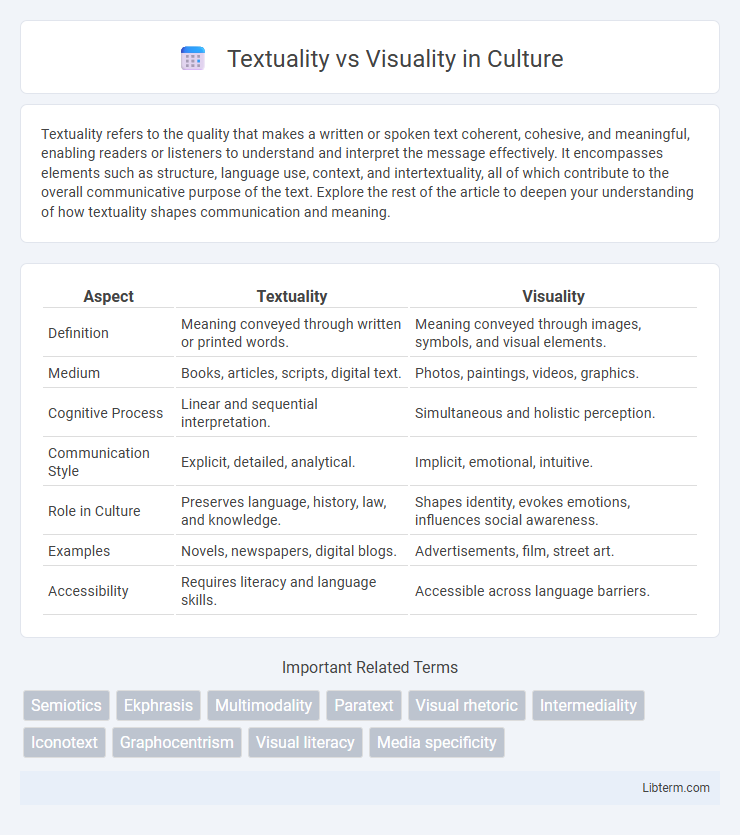Textuality refers to the quality that makes a written or spoken text coherent, cohesive, and meaningful, enabling readers or listeners to understand and interpret the message effectively. It encompasses elements such as structure, language use, context, and intertextuality, all of which contribute to the overall communicative purpose of the text. Explore the rest of the article to deepen your understanding of how textuality shapes communication and meaning.
Table of Comparison
| Aspect | Textuality | Visuality |
|---|---|---|
| Definition | Meaning conveyed through written or printed words. | Meaning conveyed through images, symbols, and visual elements. |
| Medium | Books, articles, scripts, digital text. | Photos, paintings, videos, graphics. |
| Cognitive Process | Linear and sequential interpretation. | Simultaneous and holistic perception. |
| Communication Style | Explicit, detailed, analytical. | Implicit, emotional, intuitive. |
| Role in Culture | Preserves language, history, law, and knowledge. | Shapes identity, evokes emotions, influences social awareness. |
| Examples | Novels, newspapers, digital blogs. | Advertisements, film, street art. |
| Accessibility | Requires literacy and language skills. | Accessible across language barriers. |
Defining Textuality and Visuality
Textuality refers to the quality or condition of a text based on its linguistic structure, coherence, and interpretative frameworks that emphasize written or spoken language. Visuality involves the ways in which visual elements like images, symbols, and spatial arrangements convey meaning and shape perception beyond textual language. Understanding both textuality and visuality is crucial for analyzing communication forms that integrate or differentiate language and imagery.
Historical Perspectives on Communication
Historical perspectives on communication reveal that textuality, rooted in the invention of writing systems such as cuneiform and the alphabet, facilitated the preservation and transmission of complex ideas across generations. Visuality, exemplified by cave paintings, hieroglyphs, and symbolic art, served as early non-verbal communication methods that conveyed cultural narratives and social norms. The transition from predominantly visual to textual communication marked a significant shift in cognitive processing and information dissemination in human societies.
Cognitive Processing Differences
Textuality engages left-hemisphere processes specialized in linear, sequential decoding of symbols, requiring phonological and semantic integration for comprehension. Visuality activates right-hemisphere functions responsible for holistic pattern recognition, spatial awareness, and simultaneous processing of image features. These cognitive processing differences highlight how textual information relies on language-based analytical mechanisms, whereas visual stimuli engage perceptual and imagery networks, influencing memory retention and interpretive strategies.
The Role of Language in Textuality
Language functions as the foundational element in textuality, organizing meaning through syntax, semantics, and phonology to create coherent narratives and arguments. It enables the encoding and decoding of complex ideas, allowing for abstraction and interpretation beyond literal representation. Unlike visuality, which relies on imagery and spatial perception, textuality leverages linguistic structures to convey temporal sequences and nuanced concepts essential for cognitive processing and communication.
Visual Literacy in the Digital Age
Visual literacy in the digital age demands proficiency in interpreting and creating meaning from diverse visual formats, including images, videos, and digital interfaces. Unlike textuality, which relies on linguistic structures and syntax, visuality engages cognitive processes through spatial, symbolic, and emotional cues inherent in visual media. Mastery of visual literacy enhances critical thinking and communication skills, empowering users to navigate digital environments effectively and responsibly.
Intersections of Text and Image
Intersections of text and image reveal how textuality and visuality collaboratively construct meaning through multimodal communication, enhancing user engagement and interpretation. The integration of written language and visual elements in media such as graphic novels, advertisements, and digital interfaces exemplifies the dynamic interplay where text can guide visual understanding while images contextualize or subvert textual messages. This synergy emphasizes semiotic complexity by blending linguistic codes with visual signs, offering richer narrative possibilities and cognitive resonance.
Cultural Influences on Perception
Cultural influences significantly shape the perception of textuality and visuality by determining the value and interpretation of written and visual symbols within societies. In cultures with strong oral traditions, visuality often conveys meaning more effectively than textuality, whereas literate societies prioritize text as a primary knowledge medium. Cross-cultural studies highlight how semiotic frameworks and cognitive schemas vary, impacting how individuals decode visual images and written language differently across cultural contexts.
Applications in Media and Design
Textuality emphasizes the use of written language to convey meaning, playing a crucial role in media forms such as journalism, literature, and advertising where clarity and narrative structure are vital. Visuality leverages imagery, color, and spatial design to communicate emotions and concepts rapidly, making it essential in branding, UI/UX design, and film for engaging audiences. In media and design, the strategic integration of textuality and visuality enhances user experience, ensuring messages are both informative and visually appealing.
Challenges in Interpretation
Textuality and visuality present distinct challenges in interpretation due to their reliance on different cognitive processes; textuality depends on language comprehension and sequential processing, while visuality requires spatial recognition and immediate holistic analysis. Ambiguities in language, such as polysemy and syntax complexity, often complicate textual interpretation, whereas visual ambiguity arises from elements like symbolism, context variance, and cultural differences. Effective interpretation demands an understanding of semiotic principles and contextual frameworks unique to each mode to accurately decode meaning.
Future Trends in Communication
Future trends in communication emphasize the convergence of textuality and visuality, driven by advancements in augmented reality (AR) and artificial intelligence (AI). Multimodal platforms increasingly integrate text, images, and interactive visuals to enhance user engagement and information retention. Predictive algorithms tailor visual-textual content based on user preferences, shaping personalized and immersive communication experiences.
Textuality Infographic

 libterm.com
libterm.com